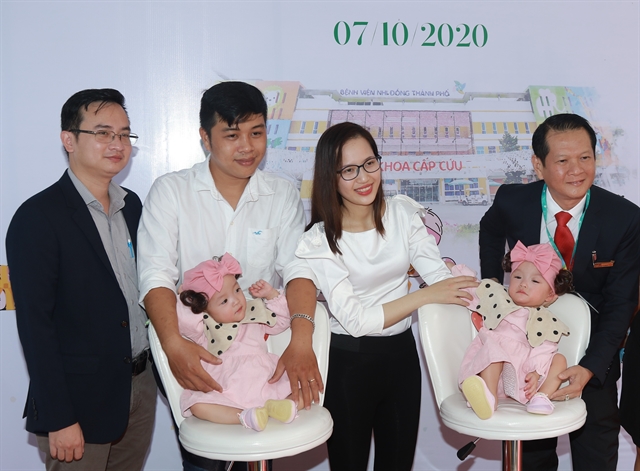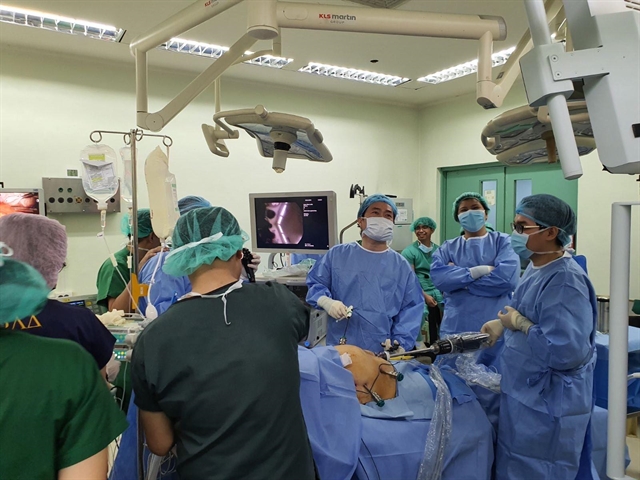 Features
Features

HCM City's Department of Health is continuing its focus on developing the application of state-of-the-art healthcare techniques at general and specialised hospitals that its counterparts in Asia have also been pursuing.
HCM City's Department of Health is continuing its focus on developing the application of state-of-the-art healthcare techniques at general and specialised hospitals that its counterparts in Asia have also been pursuing.
In recent years, many new and advanced medical techniques have helped the city's health sector obtain significant achievements in treatment and prevention.

|
| Sixteen-month-old conjoined twins who were separated by surgery at City Children's Hospital in HCM City, with their parents and doctors. VNA/VNS Photo Quang Châu |
One of the outstanding achievements was the surgery to separate 16-month-old conjoined twins in July last year by a team of nearly 100 doctors at City Children’s Hospital, Children’s Hospital 1 and 2, Chợ Rẫy Hospital and others.
Success such as this has helped the city consolidate its healthcare brand both nationally and globally.
The country’s first surgery to separate conjoined twins was performed 33 years ago at Từ Dũ Hospital when it lacked modern equipment and had to receive assistance from Japan.
The surgery at that time set a new milestone for the city's health sector. Dr Trần Đông A, who was the main surgeon to separate the conjoined twins at Từ Dũ Hospital in 1988, also took part in the surgery on the 16-month old conjoined twins last year.
Speaking at the 10th National Patriotic Emulation Congress, Dr A said that the surgery in July last year to separate the conjoined twins was ranked among the world's top 10 most complex conjoined-twin surgeries.
The twins were joined at the pelvis and abdomen, and had only one anus between them. They had two bladders located on either side of their common abdomen, an open pubic joint, and pelvises arranged in a circle.
The twins are now healthy and receiving rehabilitation therapy at the City Children’s Hospital. On April 8 this year, the hospital’s doctors performed surgery to close a temporary stomach and create a complete digestive tract for one child, while the other will have an operation to create a real anus when she is two years old.
Dr A said that the surgery was proof of the expertise of the city's surgeons, anesthesiologists and other medical workers in resuscitation in the paediatric field.
The City Children’s Hospital, which is equipped with state-of-the-art facilities and machines, opened in 2018. It is the third paediatric hospital in the city to treat severely ill patients in the city and from the southern region, and to train healthcare staff at district and province-level hospitals.
Many specialised centres in the city have been established in recent years, including the nuclear medicine centre at City Children’s Hospital, as well as others like the cardiac centre at Children’s Hospital 1 and the organ transplantation centre at Children’s Hospital 2.
Other significant medical achievements in the city include the treatment last year of the first two patients who tested positive for the coronavirus in Việt Nam at a time when COVID-19 was beginning to spread rapidly in other countries.
This achievement was proof of the professional competence of Vietnamese physicians and the Government’s efforts to control the COVID-19 pandemic.
At that time, two Chinese patients, a son who worked in HCM City and his father who was visiting him, were diagnosed with COVID-19 and treated at Chợ Rẫy Hospital.
After 14 days of treatment, the son was discharged from the hospital on February 4 last year. The father recovered and was discharged eight days later.
According to Chợ Rẫy Hospital doctors, the father suffered from diabetes, hypertension and heart disease, and had a surgical resection due to lung cancer. The doctors described the father’s recovery as an "amazing achievement".
The professional competence of physicians at hospitals in HCM City was once again affirmed following the successful treatment of Việt Nam’s most critically ill COVID-19 patient, a British pilot in his 40s.
After 107 days of treatment at the Hospital for Tropical Diseases and Chợ Rẫy Hospital, the pilot finally recovered and returned to the UK on July 12 after a request from the UK Embassy in Việt Nam. At one point, his condition was so serious that only 10 per cent of the man's lungs were functioning properly.
The COVID-19 outbreaks over the past year have been controlled well in HCM City as well as in the country, thanks to the determination and efforts of authorities at all levels as well as the public and officials working in preventive medicine.
Robot, AI applications
Other achievements in recent years include the first surgery with the assistance of a Da Vinci robot, performed by doctors at Bình Dân Hospital in the city in 2016.

|
| Doctors from the Philippines General Hospital observe doctors from Bình Dân Hospital in HCM City use robots to perform surgery on two obese patients to remove part of their stomachs. Photo courtesy of the Bình Dân Hospital |
Using a robot to assist surgery was one of several medical achievements recognised by the Ministry of Health.
Its use has contributed to developing a high-quality specialised medical centre in the city.
Bình Dân Hospital has used robots to assist doctors in treatment of more than 20 kinds of diseases, including cancer. Surgery with robots has been used on 1,256 patients.
Through a magnified 3D high-definition vision system, surgeons can direct the robot’s hands to bend and rotate 540 degrees, far more than a human hand.
In October 2017, Chợ Rẫy Hospital began using robots in minimally invasive surgery.
In early 2019, People’s Hospital 115 in the city created a new milestone in the country’s medical sector when it used a Modus V Synaptive II robot to assist surgery to remove a brain tumour from a female patient from Tây Ninh, a neighbouring province.
The robot was used to assist in the treatment of a patient who had suffered a hemorrhagic stroke, according to the city's Health Department.
The hospital was the first in Asia to use this kind of robot.
People's Hospital 115 and Gia An 115 Hospital were the first hospitals in the country to use RAPID Artificial Intelligence software to make faster and more accurate decisions on stroke diagnosis and treatment. The software was developed by Stanford University in the US.
For years, HCM City has been famous worldwide for its high-quality IVF (in vitro treatment) treatment for people who want to have children. This field has attracted the highest number of foreign patients and has helped the city develop medical tourism.
Dr Nguyễn Thị Ngọc Phượng, former director of Từ Dũ Obstetrics Hospital, was a pioneer in performing IVF technique in the country, beginning in 1997.
After 22 years of development, the country has helped assisted-reproductive technology develop rapidly in Asia.
The city's Health Department has plans to use more advanced techniques at units at Từ Dũ and Hùng Vương obstetrics hospitals and several private hospitals.
Moreover, specialised centres such as the Stroke Centre at People’s Hospital 115, the Dialysis Centre at Nguyễn Tri Phương Hospital, and the Organ Transplantation Centre at Children’s Hospital 2 are continuing to improve their quality and effectiveness.
Training doctors
Besides the development of advanced techniques in diagnosis and treatment, the city's Health Department has also asked doctors at major public hospitals to give further training to their colleagues at hospitals in many districts.
Following the department’s instruction, hospitals such as Gia Định People’s Hospital, People’s Hospital 115, Lê Văn Thịnh General Hospital and Thủ Đức City Hospital have provided comprehensive technical assistance to Bình Chánh District Hospital, District 7 Hospital and others.
The doctors from these major hospitals have performed surgeries alongside their colleagues at the district level, and have also worked with them in Red Alert emergency procedures to save severely ill patients.
Thanks to this training method, many district-level hospitals in the city have begun to perform complex surgeries.
Doctors from the trauma and orthopaedics department at Gia Định People’s Hospital and Gò Vấp District Hospital, for instance, successfully performed a hip replacement surgery in March on a 53-year-old patient who had osteonecrosis of the femoral head.
Moreover, many major hospitals in the city have opened satellite clinics at district-level hospitals to train the doctors who work there.
The city's Department of Health has also invested in upgrading or building new facilities for district-level hospitals.
Many district-level hospitals have sent their doctors to health centres at the grassroots level to provide better primary healthcare services to local residents. This has helped address the shortage of doctors in these localities and has also attracted more local residents.
Health centres in the city in recent years have invested in upgrading their facilities and bought more machines for treatment. The city has 26 ward-level health centres that operate based on family-medicine principles.
Gò Vấp Health Centre is collaborating with Gò Vấp District Hospital to provide telemedicine services to local people through an app called True Conf. The city's Department of Health plans to expand this telemedicine model to other districts. District-level hospitals and grassroots-level health centres have been told to upgrade their medical techniques.
The deputy head of the city's health department, Tăng Chí Thượng, said that the competency of staff members at grassroots-level health centres has improved, which has helped to meet local healthcare demand.

|
| The HCM City Oncology Hospital last year opened a new facility in District 9 in an effort to reduce patient overcrowding in Bình Thạnh District. Investment in the new 1,000-bed facility was more than VNĐ5.8 trillion (US$250 million). VNS Photo Gia Lộc |
New facilities
Speaking at a conference late last year, HCM City People’s Committee chairman Nguyễn Thành Phong instructed the city's health department to increase investment in facilities for hospitals and other medical establishments.
A high-tech medical cluster including hospitals and medical schools in Bình Chánh, Củ Chi and Thủ Đức districts, and Hóc Môn regional general hospital should be ready for use by 2025, Phong said.
According to the city's health authority, 54 projects have been completed. These include new or upgraded facilities, and new machine purchases for hospitals in the 2015-2020 period. Another 42 projects are ongoing.
The city has also paid more attention over the last five years to developing human resources and facilities to meet increased healthcare demand. It aims to become a professional medical centre in Southeast Asia.
The city’s ratio of doctors in 2020 has increased to 20 per 10,000 people, compared to 14.5 in 2014. The ratio of nurses was 35 per 10,000 people in 2020, compared to 33 in 2014, according to the city's health department.
The department in recent years has also improved emergency health care by developing the 115 emergency aid network in an effort to provide quality emergency activities outside city hospitals. There are now 35 satellite emergency aid stations in the city. VNS




